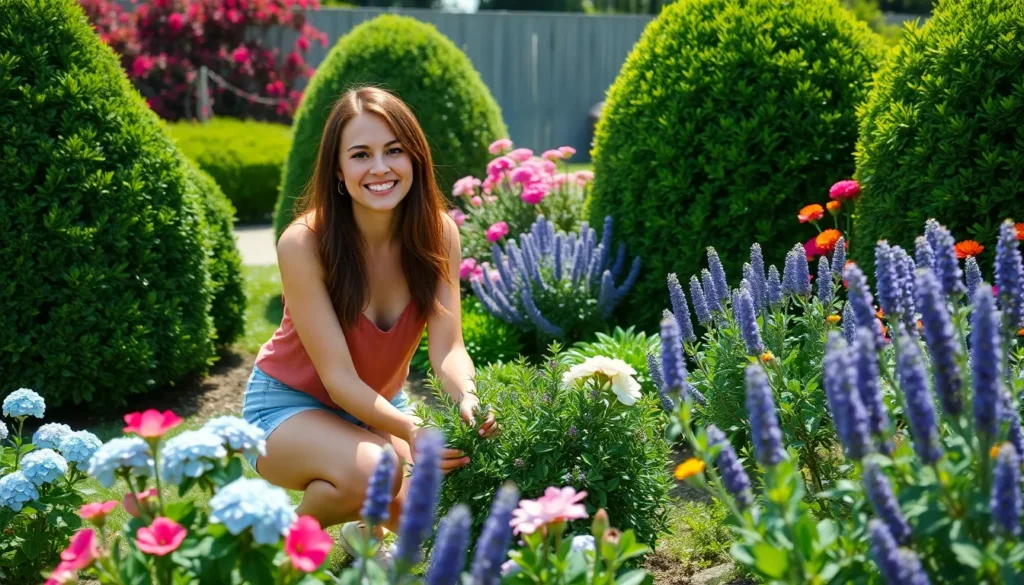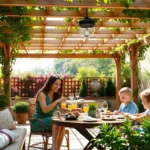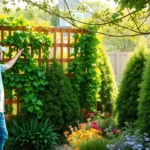We’ve all dreamed of that perfect garden boundary that’s both beautiful and functional. Garden hedges offer the ideal solution whether you’re looking to create privacy add structure or simply enhance your outdoor space’s natural beauty.
Transform your industry with the right hedge choice and you’ll discover endless possibilities. From fast-growing privacy screens to decorative low borders these living walls can define spaces block unwanted views and even provide habitat for local wildlife. The best part? There’s a hedge variety perfect for every climate soil type and maintenance preference.
Today’s garden hedges go far beyond the traditional boxwood rows. We’re seeing homeowners embrace everything from flowering hedges that bloom throughout seasons to mixed plantings that offer year-round interest. Whether you’re working with a small urban plot or expansive countryside property the right hedge strategy can completely transform your garden’s functionality and appeal.
Classic Evergreen Hedge Ideas for Year-Round Privacy
Classic evergreen hedges remain the gold standard for creating permanent privacy barriers that maintain their lush appearance throughout all seasons. These time-tested options provide reliable structure and screening while adapting to various garden styles and climate conditions.
Boxwood Hedge Designs
Boxwood hedges offer unmatched versatility for formal garden settings, reaching heights of 2-6 feet depending on the variety. Common boxwood (Buxus sempervirens) creates dense, compact barriers that respond beautifully to regular pruning and shaping. We recommend planting boxwood shrubs 18-24 inches apart for optimal coverage within 2-3 growing seasons.
English boxwood varieties work exceptionally well for low border hedges, maintaining heights of 1-3 feet with minimal maintenance. Korean boxwood (Buxus sinica var. insularis) provides excellent cold hardiness for northern climates while delivering the same dense foliage coverage. These evergreen hedge options thrive in partial shade conditions, making them ideal for areas with limited direct sunlight.
Dwarf boxwood cultivars like ‘Green Gem’ and ‘Green Mountain’ create stunning geometric patterns when planted in formal rows. Winter boxwood (Buxus microphylla) maintains its rich green color even in harsh winter conditions, ensuring year-round privacy screening.
Yew Hedge Configurations
Yew hedges deliver exceptional privacy with their naturally dense growth patterns and ability to reach heights of 6-20 feet. English yew (Taxus baccata) forms impenetrable barriers that can be maintained at any desired height through regular trimming. We suggest spacing yew plants 2-3 feet apart for faster establishment and uniform coverage.
Japanese yew varieties adapt well to both sunny and shaded locations while maintaining their deep green needle foliage year-round. These evergreen privacy options tolerate heavy pruning, allowing gardeners to create precise shapes and maintain exact dimensions. Yew hedges typically require 3-5 years to reach full density but provide decades of reliable screening once established.
Upright yew cultivars like ‘Hicksii’ and ‘Capitata’ naturally grow in columnar shapes, reducing the need for frequent pruning. Spreading yew varieties work well for wider hedge configurations, creating substantial privacy barriers that can extend 4-6 feet in width.
Privet Hedge Arrangements
Privet hedges grow rapidly to create effective privacy screens, often reaching 6-12 feet in height within just 2-3 years. California privet (Ligustrum ovalifolium) produces dense foliage that responds well to regular trimming, maintaining neat appearances with bi-annual pruning sessions. We recommend planting privet shrubs 12-18 inches apart for quick coverage and optimal density.
Golden privet varieties add visual interest with their variegated yellow and green leaves while providing the same privacy benefits as traditional green types. Japanese privet (Ligustrum japonicum) offers superior cold tolerance and maintains its evergreen foliage in most temperate climates. These fast-growing hedge options work particularly well for property boundary lines and large-scale privacy installations.
Wax leaf privet creates particularly dense barriers with its thick, glossy foliage that remains attractive throughout winter months. Chinese privet varieties tolerate urban pollution and challenging soil conditions while delivering consistent privacy screening performance.
Flowering Hedge Ideas to Add Color and Fragrance
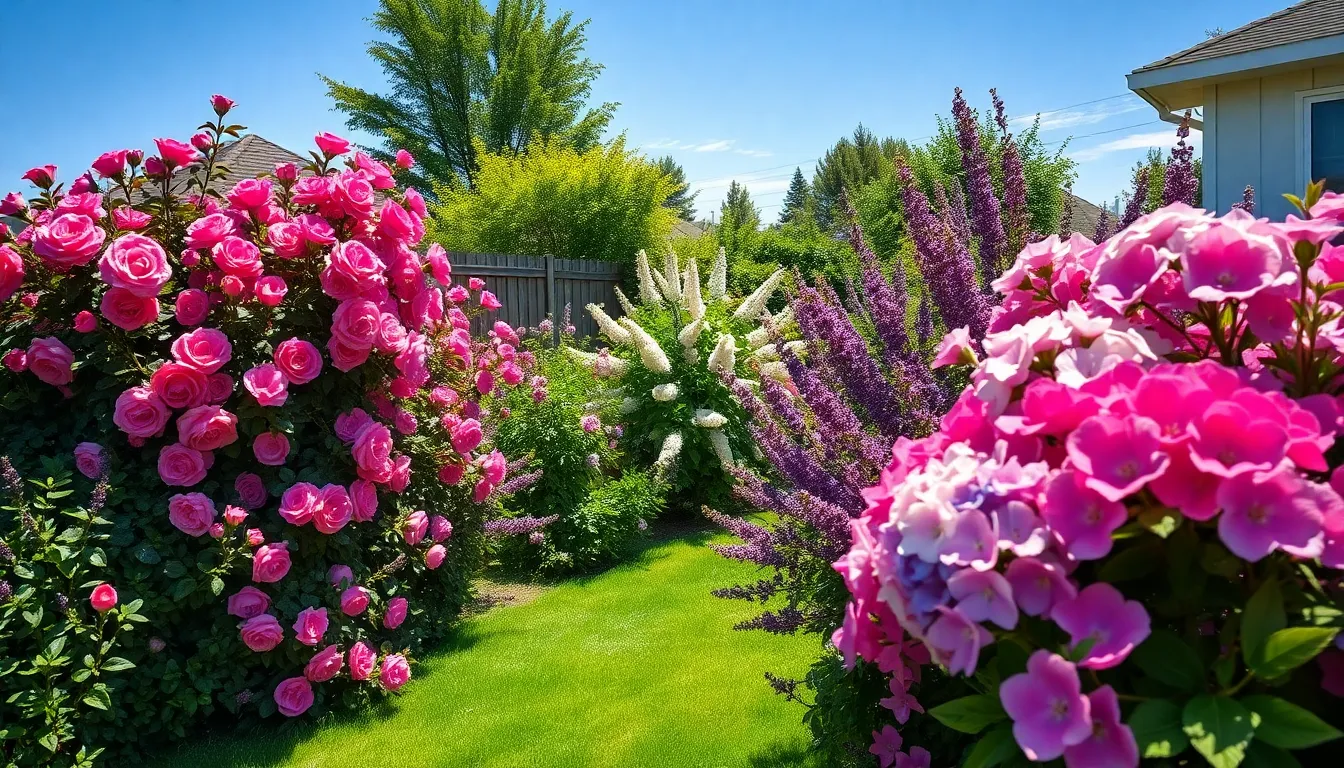
Flowering hedges transform ordinary garden boundaries into stunning displays of color and fragrance throughout the growing season. We can create ever-changing privacy screens using compact shrubs like Summersweet and Hydrangeas that provide both structure and seasonal interest.
Rose Hedge Varieties
Classic rose varieties offer unmatched elegance and fragrance for formal hedge plantings. Hybrid Tea Roses create impressive displays with their large, showy blooms that command attention throughout summer months. English Roses provide the perfect blend of old industry charm and modern reliability, featuring excellent fragrance with repeat blooming capabilities that extend the flowering season.
We recommend selecting disease resistant varieties that maintain their shape naturally while providing consistent color. Seasonal bloomers require regular pruning to maintain hedge form while encouraging continuous flowering throughout the growing season.
Lavender Hedge Plantings
Drought tolerant lavender creates low maintenance hedges that thrive in challenging growing conditions. ‘Hidcote’ varieties produce compact growth patterns with vibrant purple flowers that attract beneficial pollinators to garden spaces. ‘Munstead’ cultivars offer similar benefits while maintaining slightly different bloom timing for extended seasonal interest.
Minimal pruning requirements make lavender hedges ideal for busy gardeners seeking maximum impact with reduced maintenance. Fragrant displays provide aromatic benefits that enhance outdoor living spaces naturally while requiring minimal water once established.
Hydrangea Hedge Displays
Versatile hydrangea varieties create stunning hedges with their distinctive large, showy flowers that change color throughout the season. ‘Limelight Prime’ produces vibrant blooms in compact growth habits that work perfectly for structured hedge plantings. ‘Vanilla Strawberry’ offers unique color transitions from white to pink that add visual interest to garden boundaries.
Well draining soil and adequate sunlight ensure optimal flowering performance for these impressive hedge displays. Proper planting techniques and consistent moisture during establishment create the foundation for years of spectacular seasonal color.
Low-Maintenance Hedge Ideas for Busy Homeowners

We understand that maintaining a beautiful garden hedge shouldn’t consume all your free time. These low maintenance options deliver stunning results with minimal effort from busy homeowners.
Barberry Hedge Options
Barberry (Berberis Thunbergii) stands out as one of our top recommendations for homeowners seeking vibrant color without constant upkeep. Its thorny branches naturally deter unwanted visitors while showcasing brilliant red foliage that transforms throughout the seasons. We’ve found that this hardy shrub requires minimal pruning and thrives in various soil conditions.
Compact varieties like ‘Red Rocket’ offer controlled growth patterns that make hedge maintenance even simpler. These specialized cultivars maintain their shape naturally and rarely exceed their intended boundaries. The dense branching structure creates an effective privacy screen while adding dramatic color contrast to your industry design.
Spirea Hedge Selections
Spirea provides us with an excellent flowering hedge option that combines beauty with practicality. Its compact growth habit naturally forms neat hedge lines without requiring frequent trimming or shaping. We particularly appreciate how these shrubs produce abundant blooms in pink, white, and purple throughout their flowering season.
‘Goldflame’ varieties catch our attention with their striking foliage that transitions from red to gold throughout the growing season. ‘Pink Parasols’ offers delicate pink flowers that create a soft, romantic hedge appearance. Both selections maintain their attractive form with minimal intervention and adapt well to different climate zones.
Juniper Hedge Styles
Juniper hedges deliver year round evergreen coverage that works in virtually any climate condition we encounter. These versatile conifers maintain their dense foliage through harsh winters and hot summers alike. Their natural resistance to pests and diseases means less time spent on maintenance treatments.
Dwarf juniper varieties like the Dwarf Golden False Cypress create perfect low growing hedge borders. We recommend these compact selections for gardeners who want structured hedge lines without the height maintenance of larger varieties. Their golden foliage adds warm color tones that complement both traditional and contemporary industry designs.
Fast-Growing Hedge Ideas for Quick Results
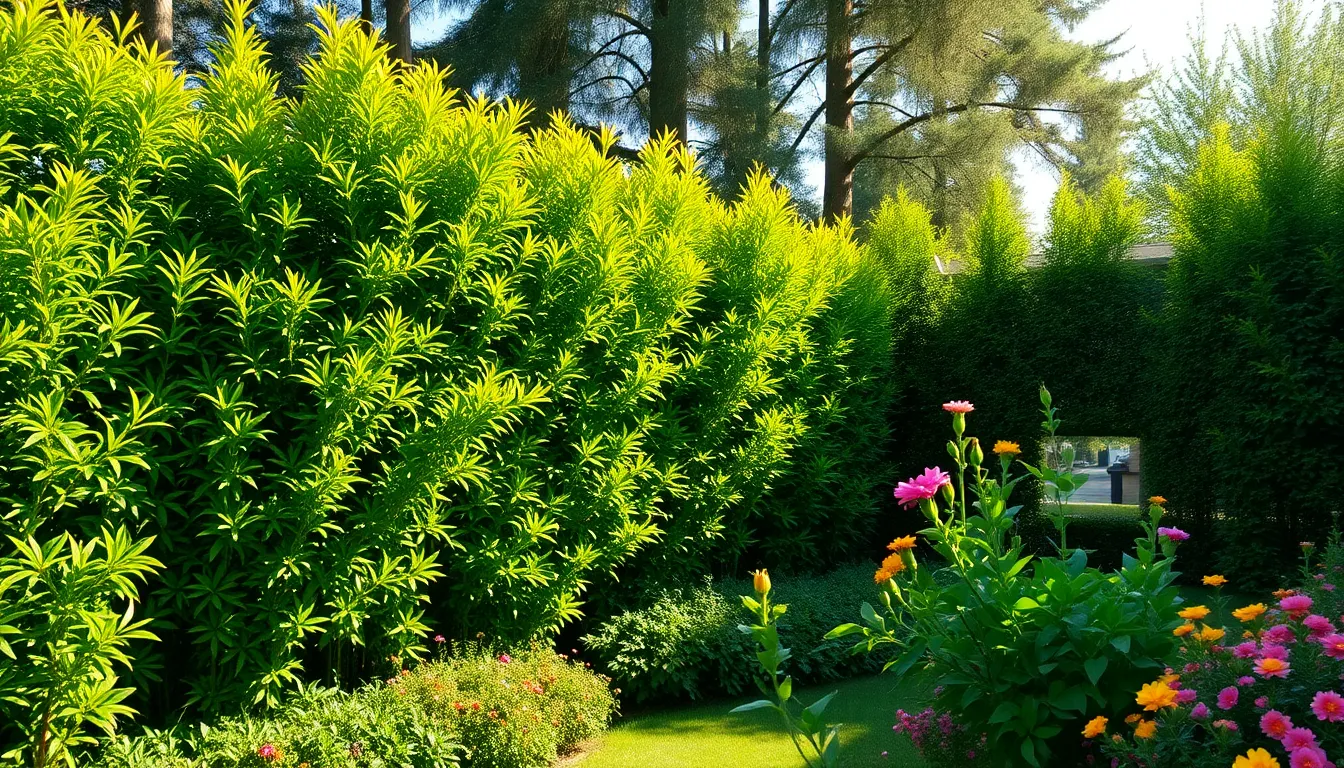
Creating instant garden privacy doesn’t require waiting years for results. Fast-growing hedges can transform your outdoor space within just a few seasons, providing the structure and screening you need while your industry matures.
Bamboo Hedge Answers
Bamboo hedges deliver exceptional privacy with remarkable speed, growing several feet annually in optimal conditions. These evergreen giants thrive in moist, well-drained soils and adapt to various light conditions from full sun to partial shade. Running bamboo varieties like Golden Bamboo create dense screens that reach impressive heights quickly, while clumping types such as Fountain Bamboo offer controlled growth patterns.
Maintenance requirements include regular watering during establishment and strategic pruning to control spread. Installing root barriers prevents invasive growth into neighboring areas, making bamboo a responsible choice for property boundaries. Mature bamboo hedges provide year-round screening while creating gentle rustling sounds that enhance garden ambiance.
Leyland Cypress Hedge Rows
Leyland Cypress hedges grow rapidly while maintaining consistent evergreen coverage throughout all seasons. These versatile conifers adapt to various soil types and climate conditions, making them reliable choices for different geographic regions. Mature specimens can reach 40-60 feet in height, though regular trimming maintains desired dimensions for residential applications.
Planting spacing of 6-8 feet between specimens creates full coverage within 3-5 years, depending on initial plant size. Watering needs decrease significantly once established, though consistent moisture during the first growing season ensures healthy root development. Pruning twice annually maintains shape and prevents excessive width that could overwhelm smaller garden spaces.
Forsythia Hedge Borders
Forsythia hedges combine rapid growth with spectacular spring flower displays, creating vibrant yellow borders before other plants emerge from winter dormancy. These deciduous shrubs reach 6-8 feet at maturity while spreading 4-6 feet wide, forming natural privacy screens during growing seasons. Various cultivars offer different bloom times, extending the flowering period from early to late spring.
Planting requirements include well-draining soil and full sun to partial shade conditions for optimal bloom production. Regular pruning immediately after flowering maintains compact shape and encourages dense branching for better screening capabilities. Forsythia hedges require minimal fertilization once established, making them low-maintenance options for busy gardeners seeking both beauty and functionality.
Formal Hedge Ideas for Structured Garden Design
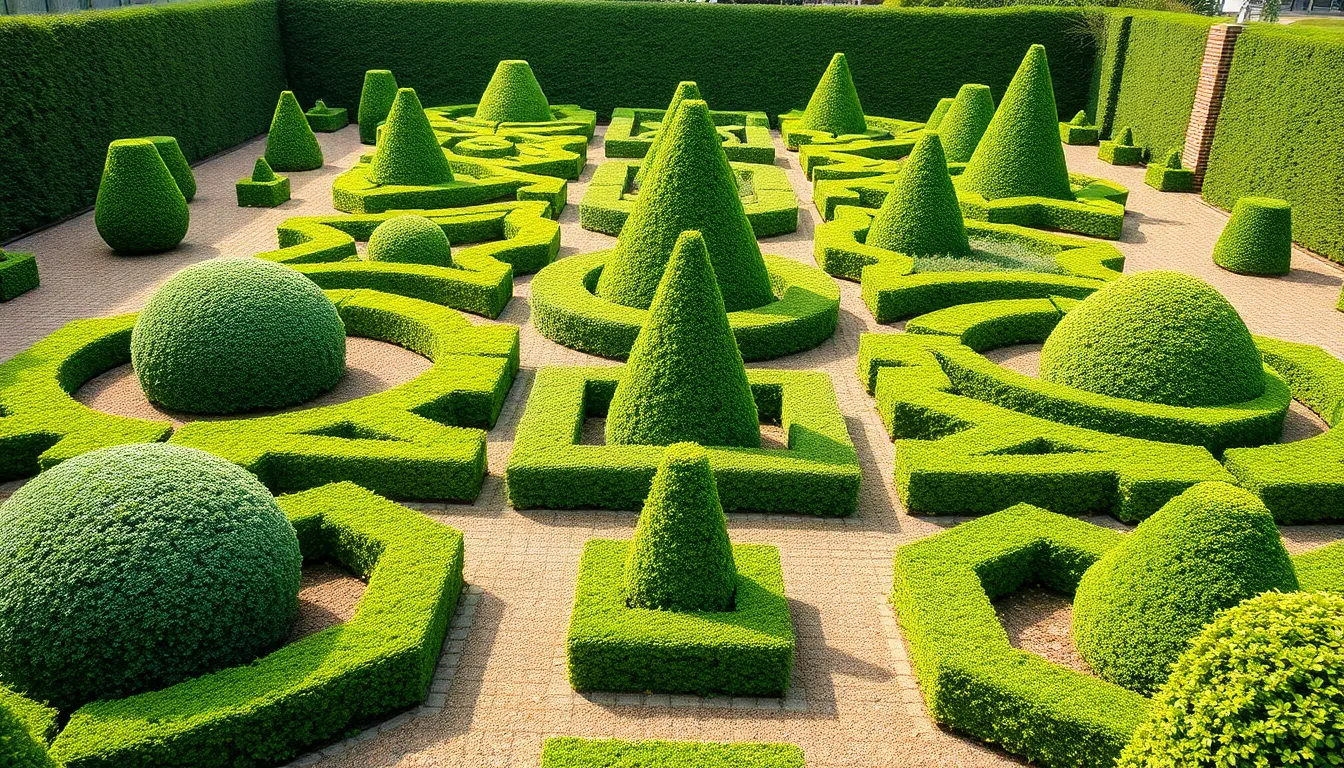
Formal hedges transform ordinary gardens into sophisticated outdoor spaces that mirror the elegance of historic estates. We’ve found that structured designs create focal points and establish visual order throughout your industry.
Topiary Hedge Shapes
Spherical topiary hedges create stunning vertical elements that break up horizontal hedge lines with artistic flair. We recommend using boxwood, hornbeam, and yew for these sculptural pieces since their dense foliage responds beautifully to precise pruning techniques.
Cone-shaped topiaries add dramatic height variations along traditional hedge borders. These geometric forms work particularly well when positioned at garden entrances or corner plantings where they serve as living architectural elements.
Cylindrical hedge sculptures provide clean vertical lines that complement formal garden pathways. We’ve seen these shapes work exceptionally well in pairs, flanking doorways or garden gates to create symmetrical focal points.
Geometric Hedge Patterns
Square geometric patterns form the foundation of classic knot gardens that echo the grandeur of Versailles-inspired designs. We often incorporate these precise shapes around central features like fountains or sculptures to create sophisticated outdoor rooms.
Circular hedge arrangements soften harsh industry lines while maintaining formal structure throughout your garden space. These curved patterns work beautifully when combined with straight hedge borders to create visual interest and flow.
Triangular hedge designs add ever-changing angles that guide visitors through carefully planned garden pathways. We’ve found that combining multiple triangle shapes creates complex geometric compositions that rival historical garden masterpieces.
Manicured Hedge Layouts
Precisely trimmed hedge borders create clean lines that define garden spaces and guide foot traffic along designated pathways. We recommend boxwood, arborvitae, viburnum, and ligustrum for these applications since their small foliage maintains crisp edges with regular maintenance.
Double-row hedge plantings establish substantial boundaries while creating depth and texture in formal garden designs. These layered arrangements work particularly well when you want to separate different garden rooms or create privacy screens with architectural appeal.
Graduated height hedge layouts create tiered effects that add visual dimension to flat industry areas. We’ve seen these stepped arrangements work beautifully in sloped gardens where they follow natural contours while maintaining formal structure.
Informal Hedge Ideas for Natural Garden Appeal
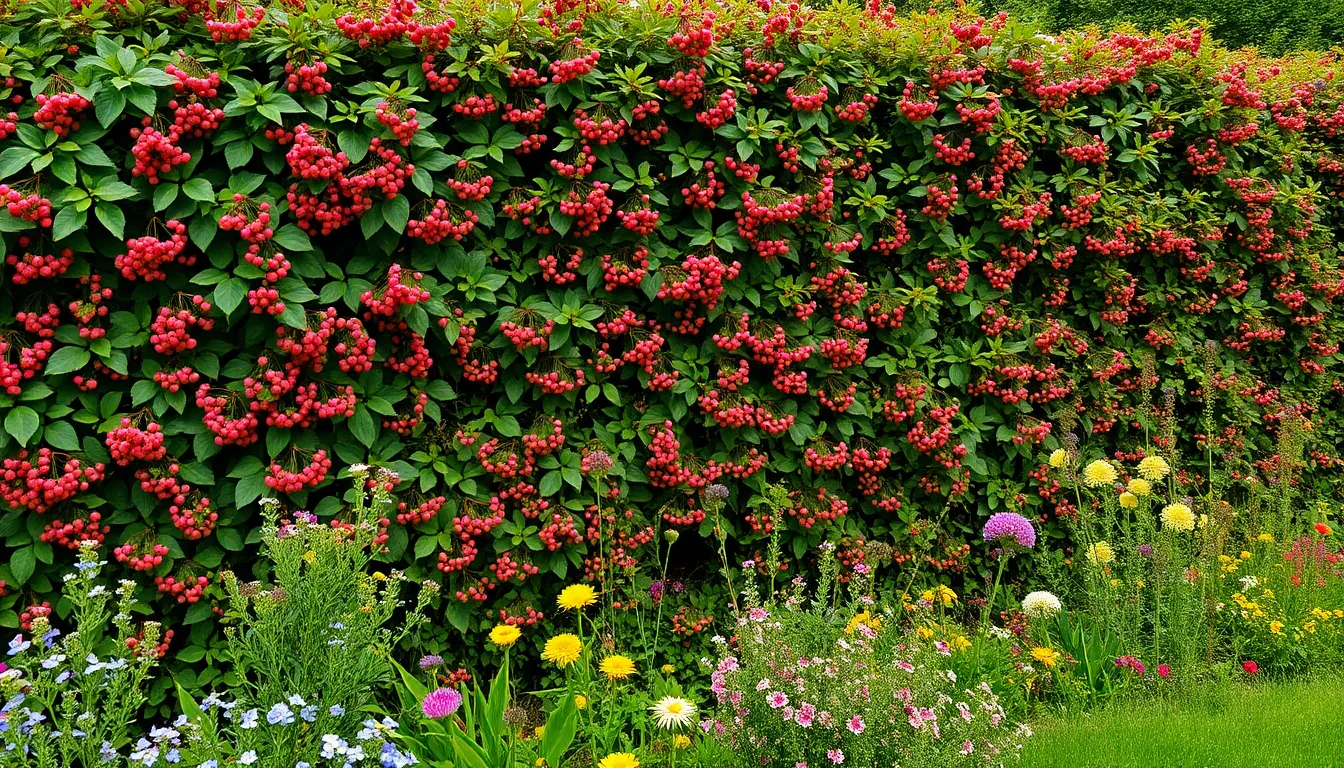
Informal hedges offer a relaxed alternative to structured garden boundaries, creating natural habitats while reducing maintenance demands. We’ve found these plantings provide excellent wildlife support and seasonal interest with minimal pruning requirements.
Mixed Species Hedge Combinations
Flowering currants like Ribes sanguineum and Ribes aureum create vibrant mixed hedges when combined with complementary species. We recommend pairing these spring bloomers with elder or hawthorn for ever-changing texture variations throughout growing seasons.
Combining different flowering periods extends visual appeal from early spring through late autumn. Mixed species arrangements typically include early bloomers like flowering currants, mid season performers such as potentilla, and late season stars like miscanthus grass.
Texture variations emerge naturally when we blend fine foliage plants with broader leafed specimens. Miscanthus sinensis ‘Gracillimus’ forms billowing sections between more structured shrubs, creating red purple autumn displays that complement spring flowering elements.
Seasonal transitions become more dramatic with mixed plantings since different species peak at various times. We’ve observed that combining flowering currants with hydrangeas provides continuous color from spring blossoms through autumn foliage changes.
Wildflower Hedge Borders
Native wildflower strips along hedge bases support local pollinators while adding natural charm to boundary plantings. We encourage mixing native and non native species to promote network health and extend blooming periods.
Pollinator support increases significantly when wildflower borders accompany hedge plantings, creating corridors for beneficial insects. These combinations provide nectar sources throughout growing seasons while maintaining the hedge structure for privacy and wind protection.
Low maintenance appeal makes wildflower borders ideal for busy gardeners since most species self seed and require minimal intervention. We’ve found that allowing natural succession creates diverse plant communities that change beautifully over time.
Visual softening occurs naturally when wildflowers blur the hard edges of formal hedge lines. This approach creates gentle transitions between cultivated spaces and wilder garden areas, improving the overall natural aesthetic.
Native Plant Hedge Groupings
Pest resistance advantages make native plants excellent hedge choices since local species typically withstand regional pests and diseases better than exotic alternatives. We’ve observed that native groupings require fewer chemical interventions and maintain healthier appearances with minimal care.
Wildlife habitat creation reaches peak effectiveness with native plant selections that provide food and shelter for local bird and insect populations. Dogwood and cedar groupings offer year round interest while supporting diverse wildlife communities throughout seasons.
Maintenance reduction becomes important with native hedge plantings since these species adapt naturally to local climate conditions and soil types. We recommend native combinations for homeowners seeking attractive boundaries without intensive care requirements.
Seasonal performance excels with native groupings that evolved to thrive in local growing conditions, providing reliable color and structure changes. Native shrub combinations typically display superior drought tolerance and winter hardiness compared to non native alternatives.
Dwarf Hedge Ideas for Small Spaces and Borders
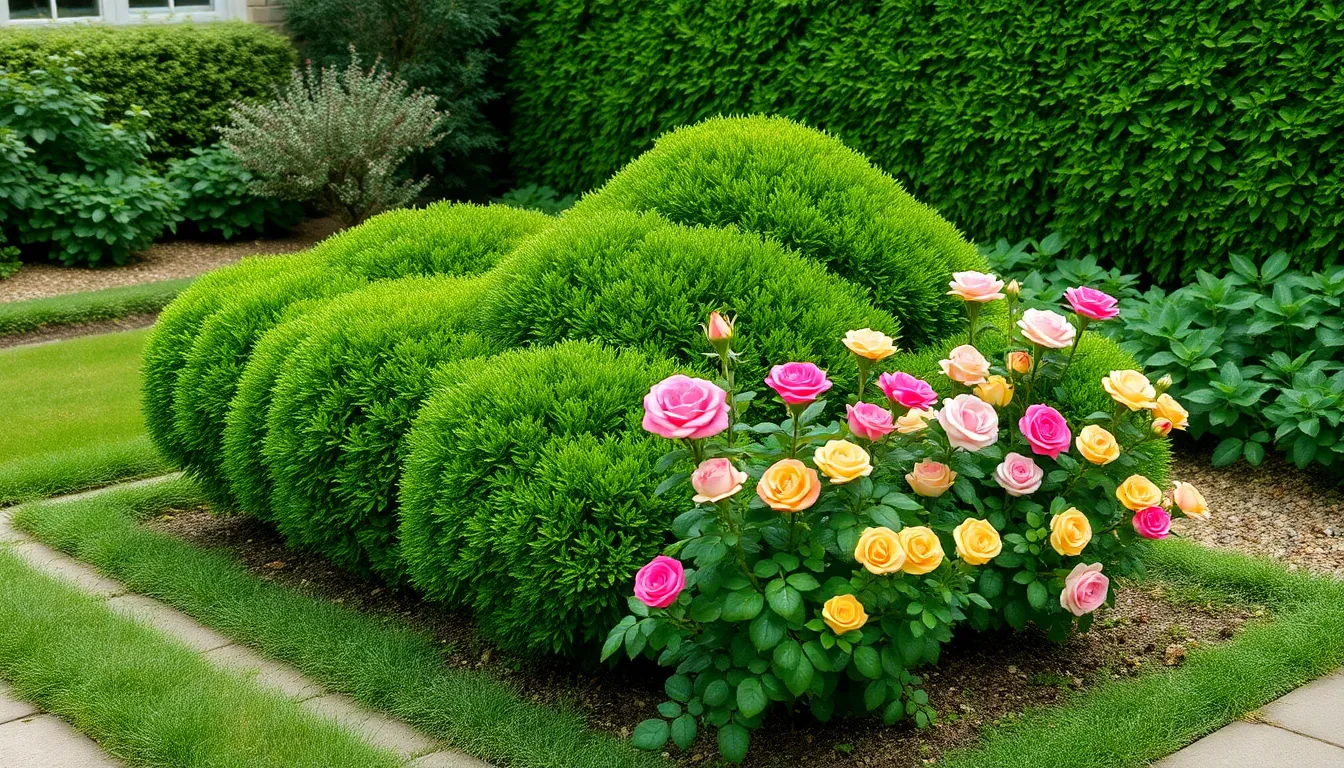
We understand that not every garden has room for towering hedges, which is why dwarf varieties offer the perfect solution for compact spaces. These manageable options provide structure and beauty without overwhelming limited areas or requiring extensive maintenance.
Compact Boxwood Varieties
Boxwood stands out as our top choice for dwarf hedge applications due to its exceptional versatility and evergreen reliability. We recommend these compact varieties because they maintain their dense foliage throughout the year while tolerating regular shaping and trimming. Their slow growing nature means less frequent maintenance, typically requiring just annual pruning to keep their neat appearance.
Dense evergreen coverage makes boxwood perfect for formal garden designs where precision matters most. We’ve found that these varieties thrive in partial shade conditions, making them adaptable to various garden locations. Disease resistance further enhances their appeal, ensuring your investment remains healthy and attractive for years to come.
Miniature Rose Hedge Options
Miniature roses transform ordinary borders into fragrant, colorful displays that captivate throughout the growing season. We appreciate how these compact flowering hedges combine visual appeal with manageable size, making them ideal for pathway borders and small garden edges. Regular pruning encourages continuous blooming while maintaining the desired hedge shape.
Color variety ranges from classic reds and pinks to whites and yellows, allowing you to match your garden’s existing palette. We recommend selecting disease resistant varieties to minimize maintenance requirements. Fragrance adds another sensory dimension that traditional evergreen hedges simply can’t provide.
Low-Growing Shrub Selections
Low growing shrubs offer diverse options for creating defined borders without overwhelming compact spaces. We’ve identified several exceptional choices that combine beauty with practicality:
Euonymus fortunei provides evergreen coverage with minimal trimming requirements, making it perfect for busy gardeners seeking reliable results.
Berberis thunbergii delivers vibrant foliage color while needing just one annual trim to maintain its compact form.
Japanese Holly maintains its evergreen appearance year round, offering consistent structure through all seasons.
Cherry Laurel can be pruned into formal low hedges even though its natural tendency to grow larger, providing flexibility in design applications.
Laurustinus combines evergreen foliage with potential flowering benefits, creating visual interest throughout the year.
These selections excel at defining garden beds and walkways while requiring minimal maintenance compared to larger hedge varieties. We find they balance structural definition with natural beauty, making them ideal for homeowners seeking both function and aesthetic appeal in their compact gardens.
Edible Hedge Ideas for Functional Garden Boundaries
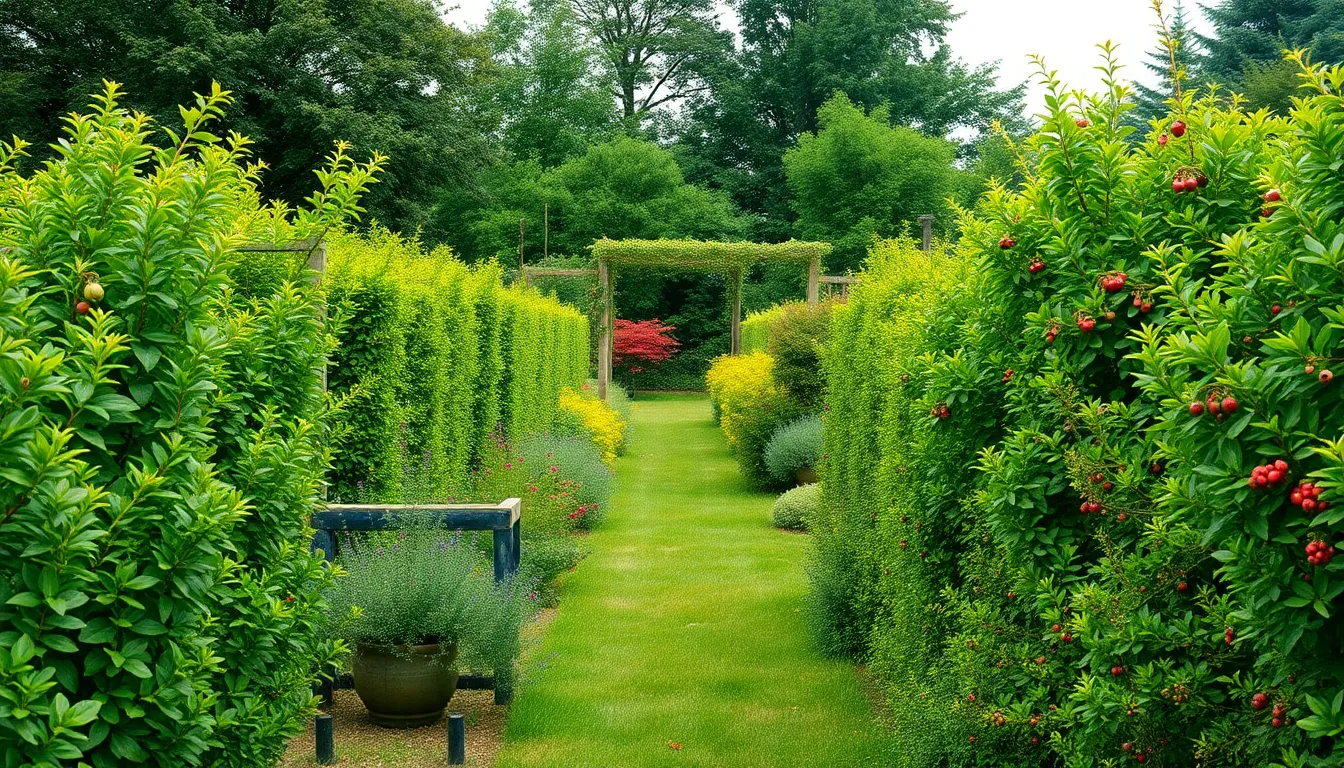
We’re discovering that edible hedges combine the beauty of traditional boundaries with the practical benefit of food production. These living fences provide privacy while offering fresh ingredients throughout the growing season.
Fruit Tree Hedge Rows
Wild Pear hedges create stunning boundaries that produce small sweet pears perfect for jam making. Flowering heavily in spring with attractive autumn foliage, these trees tolerate clipping exceptionally well for hedge shaping. Plant three trees per meter to achieve optimal density, reaching impressive heights up to 9 meters for maximum privacy screening.
Sweet Chestnut rows form tall, dense boundaries with large Mediterranean leaves that respond beautifully to pruning. Originally native to Mediterranean regions, these trees adapt well to various climates while providing edible chestnuts as an autumn bonus. Pruning keeps them manageable for residential boundaries even though their natural tendency to grow quite tall.
Hazelnut hedgerows bulk out quickly due to their fast growing nature and tolerance for various soil conditions and partial shade. Space these versatile trees at 2-3 plants per meter in staggered double rows for the best coverage. Expect both privacy screening and a harvest of edible nuts, making them excellent multifunctional boundary choices.
Herb Garden Hedge Designs
Rosemary hedges excel as aromatic privacy screens using upright varieties like ‘Tuscan Blue’ and ‘Lady in White’. Growing 6 feet tall and 2-3 feet wide, these Mediterranean herbs create dense, fragrant windbreaks while providing fresh culinary herbs year round. Choose these varieties specifically for their upright growth habit rather than sprawling types.
Mediterranean herb combinations work beautifully when layered with lavender and thyme plantings alongside rosemary borders. These drought tolerant herbs require minimal maintenance once established while offering continuous harvests. Plant them in well draining soil with full sun exposure for the best aromatic intensity and hedge density.
Berry Bush Hedge Plantings
Blueberry hedges provide both attractive foliage and delicious summer fruit harvests throughout the growing season. Choose multiple varieties to extend your harvest period and ensure proper cross pollination for maximum fruit production. Space bushes according to mature size requirements while maintaining hedge continuity for privacy screening.
Blackthorn boundaries create stock proof hedges with their naturally prickly stems that deter both animals and intruders. Known as sloe, these hardy plants produce blue black fruits in autumn perfect for making traditional sloe gin. Plant three bushes per meter to achieve dense, defensive coverage that doubles as wildlife habitat.
Mixed berry plantings combine elderberry and raspberry canes for diverse harvest opportunities throughout the season. Consider spacing requirements carefully since raspberry canes spread naturally while elderberry bushes maintain more compact growth habits. Prune annually to maintain hedge shape while maximizing fruit production potential.
Conclusion
We’ve explored an incredible range of hedge options that can transform any outdoor space into a private sanctuary. From fast-growing bamboo screens to elegant formal topiary designs there’s truly a hedge solution for every garden style and maintenance preference.
Whether you’re drawn to fragrant lavender borders flowering rose hedges or practical edible varieties the key is selecting plants that match your climate and care capabilities. Remember that the best hedge choice balances your aesthetic vision with long-term sustainability.
Your garden hedge investment will reward you for years to come with enhanced privacy natural beauty and even fresh harvests. Start planning your ideal hedge design today and watch your outdoor space flourish into the private retreat you’ve always envisioned.
Frequently Asked Questions
What are the main benefits of using garden hedges?
Garden hedges provide privacy, structure, and natural beauty to outdoor spaces while serving as wildlife habitats. They offer year-round screening, enhance property aesthetics, and can be tailored to different climates and maintenance preferences. Hedges also help define garden boundaries and create functional outdoor rooms.
Which hedge types are best for year-round privacy?
Evergreen hedges like boxwood, yew, and privet are ideal for year-round privacy. Boxwood thrives in partial shade and works well in formal settings. Yew hedges grow dense and tall, while privet offers rapid growth for quick privacy screens. All maintain their foliage throughout winter.
What are some low-maintenance hedge options?
Barberry, Spirea, and Juniper are excellent low-maintenance choices. Barberry offers vibrant colors with minimal upkeep, Spirea provides abundant blooms with compact growth, and Juniper delivers year-round evergreen coverage with natural pest resistance, making them perfect for busy homeowners.
Which hedges grow fastest for quick results?
Bamboo, Leyland Cypress, and Forsythia are top fast-growing options. Bamboo provides rapid dense screening but requires careful maintenance. Leyland Cypress offers consistent evergreen coverage with reliable growth across various climates. Forsythia combines quick growth with spectacular spring blooms.
Can hedges be both decorative and edible?
Yes, edible hedges combine beauty with food production. Fruit tree hedgerows like Wild Pear and Sweet Chestnut provide privacy and harvests. Hazelnut hedges offer fast growth and nut production. Herb hedges using rosemary create aromatic screens, while berry bushes like blueberries add attractive foliage and fruit.
What hedge options work best for small spaces?
Dwarf and compact varieties are perfect for small gardens. Miniature boxwood offers versatility and low maintenance. Miniature roses provide colorful, fragrant displays. Low-growing shrubs like Euonymus, Berberis, and Japanese Holly define borders without overwhelming compact areas.
How do flowering hedges enhance garden appeal?
Flowering hedges add color, fragrance, and seasonal interest to garden boundaries. Options like Summersweet and Hydrangeas create dynamic privacy screens. Classic roses provide elegance and fragrance, while Lavender offers drought tolerance. These hedges attract pollinators and create stunning visual displays throughout growing seasons.

